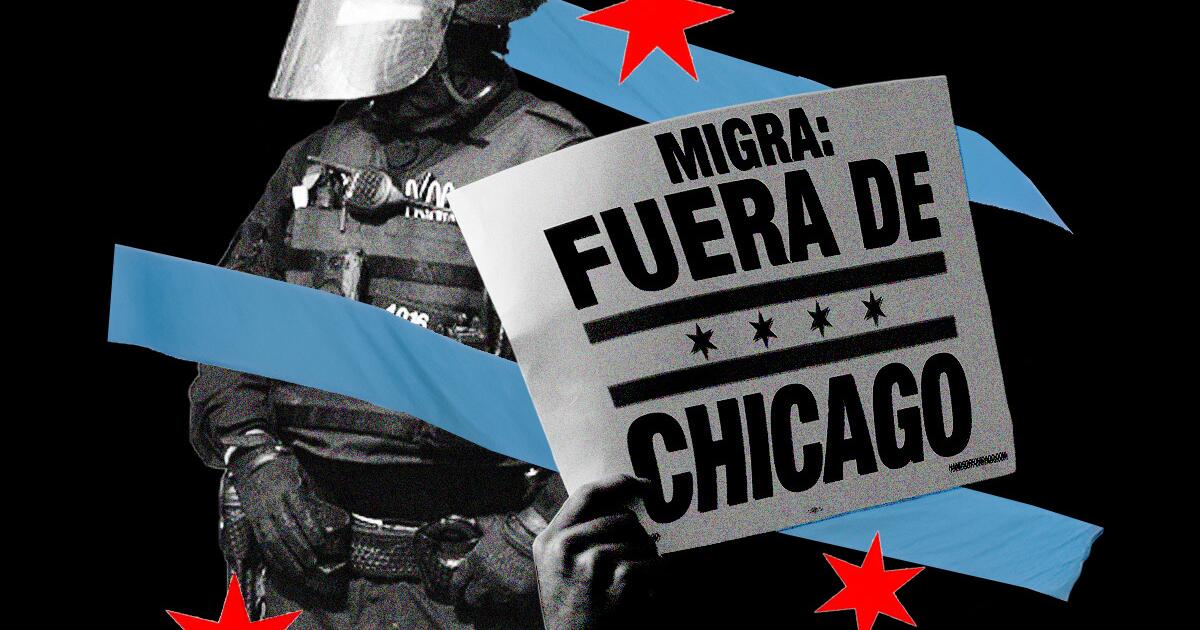Los Angeles was just the prelude.
The Department of Homeland Security has been carrying out a large-scale immigration enforcement campaign in Chicago — dubbed “Operation Midway Blitz” — since early September, detaining at least 1,000 people in the process.
As my colleague Susan Rust highlights in her recent dispatch from Chicago, what’s happening there feels like a mirror image of what transpired here over the summer.
You’re reading Latinx Files
Fidel Martinez delves into the latest stories that capture the multitudes within the American Latinx community.
By continuing, you agree to our Terms of Service and our Privacy Policy.
The Trump administration has justified unleashing federal agents on the country’s third-largest city by portraying it as a “war zone,” alleging that Illinois’ status as a sanctuary state has resulted in undocumented criminals running rampant on the streets of Chicago.
The White House even released a cinematic video on social media showing agents putting a stop to all the lawlessness in the area. Except, it turns out some of the footage used in the clip was outdated and wasn’t even filmed in Chicago.
In fact, the only scene remotely resembling a war zone was caused by federal agents, who in the early morning of Sept. 30 literally descended from Black Hawk helicopters to an apartment building in Chicago’s South Shore neighborhood that was alleged to be a hot spot for members of Tren de Aragua, a multinational criminal organization with roots in Venezuela.
Agents from Immigration and Customs Enforcement, the Federal Bureau of Investigation and U.S. Border Patrol zip-tied and detained hundreds of residents outside of the building. In the end, the military-style raid resulted in the arrest of 37 individuals, only one of whom had any connection to Tren de Aragua.
“I’ve been on military bases for a good portion of my life,” Darrell Ballard, who lives next door to the apartment complex, told CNN. “And the activity I saw — it was an invasion.”
In reality, as was the case in L.A., it’s been business as usual for large swaths of Chicago — last Sunday, 50,000 runners hit the city’s streets for the Chicago Marathon, which went off without a hitch. Much of the immigration enforcement activity has been concentrated in predominantly Latino neighborhoods, deeply impacting those communities. Students have stopped going to class and local businesses have seen their bottom lines affected.
“Business is down 60%,” Victor Sanchez, who owns a taco truck in Chicago, told The Times. “I don’t know if they have been taken, or if they are too afraid to come out. All I know is they aren’t coming here anymore.”
Since the start of Operation Midway Blitz, federal agents have: fired pepper balls at a pastor in the head (an action defended by DHS Assistant Secretary Tricia McLaughlin); deployed tear gas in a busy neighborhood; arrested a local police officer whom they accuse of overstaying his visa; detained an alderperson checking in on a constituent, as well as a WGN producer who was simply walking to a bus stop; orchestrated a PIT maneuver on a vehicle; and shot and killed a man shortly after he had dropped off his daughter at school.
Perhaps unsurprisingly, Trump’s immigration enforcement campaign appears to be losing the battle of public opinion. According to an Economist/YouGov poll released last week, the majority of people surveyed said that ICE agents have been using excessive force, that they should wear uniforms while conducting arrests and that they should not be allowed to wear masks while doing so.
At least one Democratic politician is already looking to retaliate.
“The tables will turn one day,” Illinois Gov. J.B. Pritzker said in an interview with Fox 32 Chicago of federal agents. “These people should recognize that maybe they’re not gonna get prosecuted today, although we’re looking at doing that, but they may get prosecuted after the Trump administration because the statute of limitations would not have run out.”
If all of this feels bleak and you’re looking for a silver lining, I’ll offer this. Much like we saw in L.A., Chicagoans are stepping up for their most vulnerable neighbors — from blowing whistles alerting people of the presence of federal agents to organizing street vendor buyouts.
Consider subscribing to the Los Angeles Times
Your support helps us deliver the news that matters most. Become a subscriber.
Día DE LOS Muertos is upon us!
In 2021, the Times published its first Día de Muertos digital altar. The project was born out of a desire to virtually replicate the communal experience found in the many events observing the holiday held across Southern California that were canceled that year because of the COVID-19 pandemic.
On Wednesday, the fifth iteration of the digital altar went live.
The tool lets readers make an ofrenda by uploading a photo of a loved one who has passed along with a short written message. These submissions are manually reviewed by a De Los staffer before they’re added into the community altar.
I’ll be writing more about the holiday’s growing significance for me in next week’s newsletter. In the meantime, staff writer Andrea Flores has compiled this helpful list of 28 Día de Muertos events taking place in the region over the next two weeks.
De Los will also be hosting its own celebration Nov. 25 at Las Fotos Project in Boyle Heights. The event will feature a public altar, face painting, a paper marigold workshop by Self Help Graphics and a sugar skull decorating class hosted by Tia Chucha’s Centro Cultural and Bookstore. Admission is free, but will require an RSVP. To learn more and to sign up, you can go here.
Stories we read this week that we think you should read
Unless otherwise noted, stories below were published by the Los Angeles Times.
ImmigrationArts, culture and mediaSports
- “Call ICE”: Brewers backer taunts Dodgers fan, is now out of a job.
- New study details impact of Latinos on U.S. sports economy. [Today]
